How Much Does it Cost to Develop a Fintech App and It’s Types

By Shravan Rajpurohit
May 7, 2024
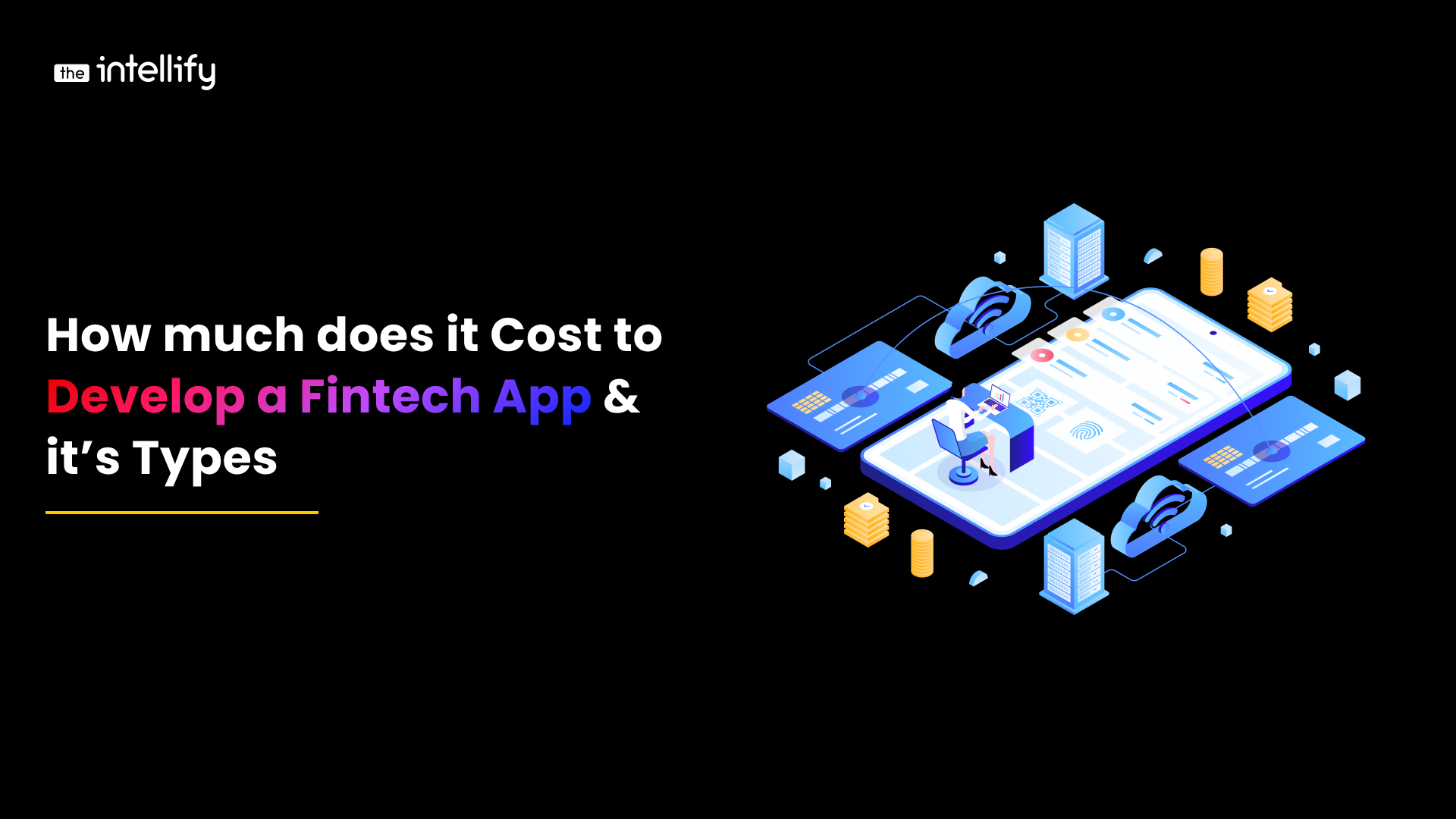
FinTech applications, the true game-changers of the digital era, are revolutionizing how we handle our finances. From investing platforms to mobile banking, these apps offer efficiency, security. And ease of use, completely transforming financial transactions into a digital realm. The intricate development process behind their slick interfaces and flawless performance requires thoughtful preparation. And financial commitment, underscoring the transformative power of these apps.
This blog is your comprehensive guide to FinTech app development. It offers a deep dive into the critical elements determining costs. The essential features contributing to these apps’ success, and how to select a development partner like The Intellify.
What is a Fintech App?
Fintech apps are web-based or mobile application development that enhance financial processes or provide financial services via technology. Some examples of these apps are mobile banking, investments, planning, and payment systems. When developing new features, such as automated investing, risk assessment. And safe transactions often use cutting-edge technology like blockchain and machine learning. Users may expect streamlined, hassle-free, and more effective financial management using fintech applications.
Features of Fintech Apps
Here are some vital features of fintech apps:
Simple UI / UX Design: design promotes reliability and comfort.
Authentication and biometrics: State-of-the-art security protocols guarantee the protection of user data.
Easy Orientation: Encouraging a seamless introduction enhances user engagement.
Push Notifications: Users may take swift action with the help of instant alerts.
Multi-layered security: User accounts are safeguarded by encryption and fraud detection.
Compatibility with Many Platforms: All devices may access it.
Custom Dashboards: A more satisfying user experience is achieved via a tailored approach.
DigitalWallets: Quick and safe transactions for the benefit of users.
Integration of AI: Personalized suggestions and safeguarding against fraud.
Reporting and Analytics: Knowledge allows for well-informed choices to be made.
Customer Support: Responding to customer service inquiries establishes credibility and loyalty.
Types of FinTech Apps
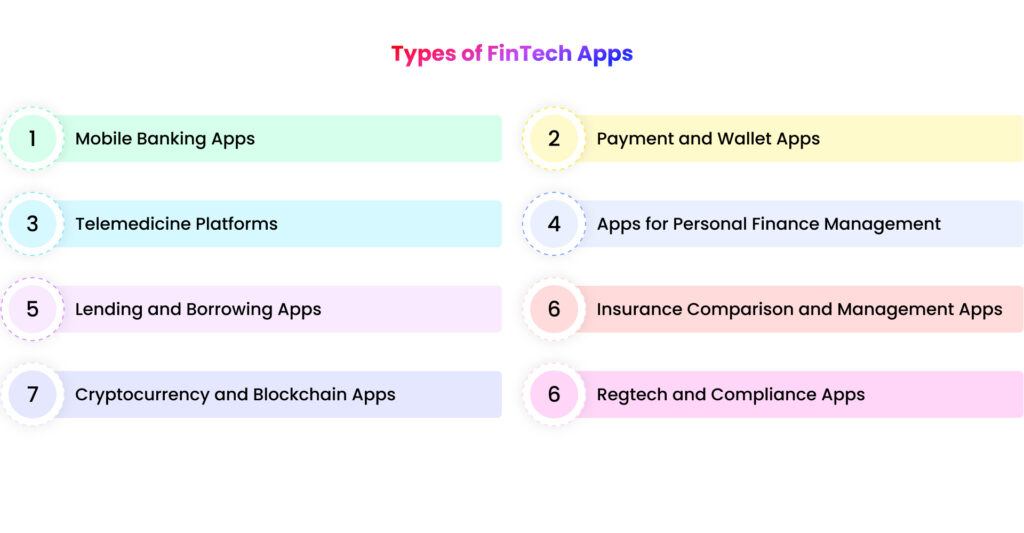
FinTech is the umbrella term for many applications that use technology to enhance and simplify financial services. These apps provide creative solutions suited to the requirements of contemporary consumers. And businesses, covering a range of personal and business finance-related topics. The following are a few of the most popular kinds of FinTech apps:
1. Mobile Banking Apps
With capabilities like bill payment, fund transfers, and account balance queries. Mobile deposits and mobile banking apps let users manage their money while on the go. They can also access accounts using smartphones or tablets, offering a handy substitute for traditional brick-and-mortar banking, allowing users to do it whenever and wherever they choose.
2. Payment and Wallet Apps
Payment apps have completely changed how consumers buy by providing easy and safe payment options. These programs range from mobile wallets like Apple Pay. And Google Pay to peer-to-peer (P2P) payment apps like Venmo. And PayPal enables transactions over digital channels, eliminating the need for actual currency and credit cards.
3. Investment and Trading Apps
Due to the growth of commission-free trading and robo-advisors, new. And seasoned investors use investment and trading apps more. These apps permit users to buy and sell cryptocurrencies, stocks, exchange-traded funds (ETFs). And other assets, often with affordable costs and intuitive user interfaces.
4. Apps for Personal Finance Management
These applications assist users in budgeting, goal-setting, and spending tracking. By combining financial information from many accounts and sources. These applications give users a better understanding of their spending patterns. And empower them to make wise financial decisions.
5. Lending and Borrowing Apps
FinTech lending platforms serve people and small enterprises needing help obtaining credit through conventional channels by providing alternative financing solutions to traditional banks. By streamlining the lending process through technology. These apps enable borrowers to get loans at a lower cost.
6. Insurance Comparison and Management Apps
These apps enable customers to make claims, maintain coverage, and compare insurance policies. These applications help consumers select the finest coverage alternatives at affordable rates, streamlining the insurance purchasing process.
7. Cryptocurrency and Blockchain Apps
These applications let users buy, sell, store, and handle digital currencies like Ethereum, Litecoin, and Bitcoin. They also enable smart contracts and blockchain-based transactions, providing consumers safe. And decentralized alternatives to conventional financial systems.
8. Regtech and Compliance Apps
Regtech and compliance apps assist financial organizations in automating compliance procedures. Monitoring regulatory modifications and guaranteeing conformity to industry standards. These applications are essential for helping companies navigate. And intricate regulatory frameworks and reduce compliance risks.
How Can a FinTech Application Be Developed?
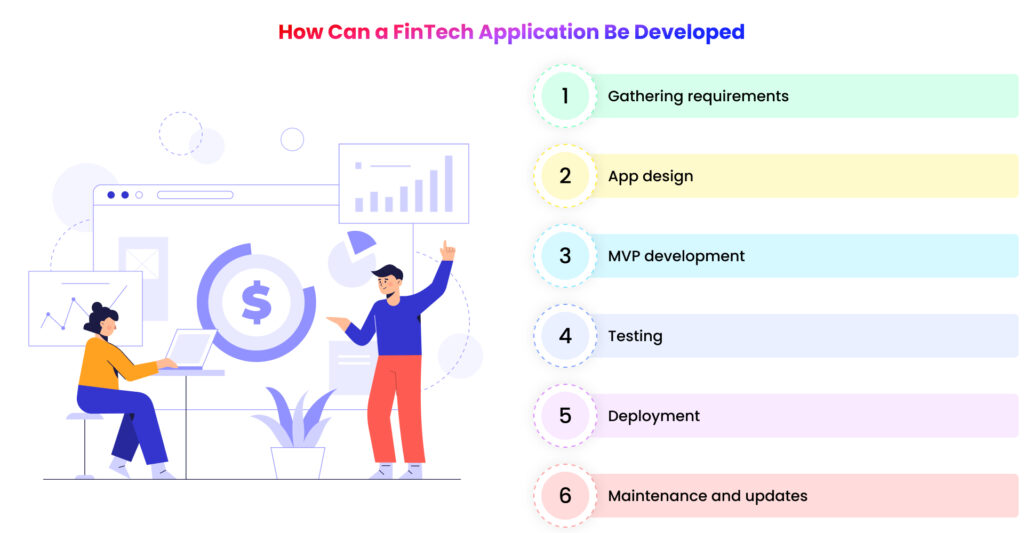
The development of a successful FinTech app involves a series of meticulous steps. When followed, these steps can lead to a FinTech app that delivers tangible results.
- Gathering requirements: This phase entails discussing your project’s specifications with the FinTech AI app development business like The Intellify.
- App design: The next step in building the app is creating an engaging user interface and user experience (UI/UX).
- MVP development: At this point, the finest security practices are incorporated, and features are programmed. And technologies are introduced to create an app that best captures your project’s unique selling point.
- Testing: In this phase, your development team, like The Intellify, will test the MVP to ensure it is bugs-free.
- Deployment: At last, the software is made available on the platform of your choice, either iOS, Android, or both.
- Maintenance and updates: Based on user feedback, new features and functionality are often added to the app to keep the product growing.
Cost to Develop FinTech Applications?
The cost of developing a FinTech application is not set in stone. Each company’s demands and goals are different, influencing how much it costs to design a FinTech application. The app development company type, features, functionality, and location. And development time are some aspects that affect an app’s development cost.
The minimal cost of developing a unique FinTech application that offers users security. And straightforward online transaction method may be $40,000.
A FinTech application with basic functionality and user interface costs $30,000 to $100,000. Depending on the complexity of the application, integrating new and improved solutions may cost anywhere from $60,000 to $300,000 or more.
Elements Affecting the Price of Developing a FinTech App
The cost of developing a FinTech application is not calculated. Many circumstances and causes have a significant influence on the entire budget. Elements and features of FinTech apps are:
Product specifications
The app specifications are the first factor influencing the cost of developing a FinTech application. App requirements are divided into two categories:
The scope of work
The scope is the set of features the financial application must have or the work required to develop these features. The project’s scope determines its size and the hours needed to complete its development.
The complexity degree of the product
Project complexity describes the conceptual complexity of a software product. Complex logic and concepts make building, testing, and implementing a product more challenging.
A dynamic UI/UX
Developing financial software with an intuitive UI is a rewarding try. The smooth app design enhances the user experience. An application must be built, starting with selecting the right fonts, adequate use of white space, and basic terminology. Users may locate the information they need using an efficient app. If you want your app to become popular, this is also necessary. So, investing in a design for your program is always a good idea.
The Time Needed to Develop a FinTech Mobile App
Delivery time impacts the cost of developing FinTech applications. Faster development and prototyping need more teamwork. So, the team working on the project with the quickest delivery date will be more expensive. The amount of time needed to design a financial application in its entirety also depends on the kind of mobile application being created.
Development Partner’s Location
Another important issue that affects the cost is the location of the company you have partnered with to develop your FinTech application. The hourly rate of the four to seven specialized teams determines the price. And the duration required to develop an app in a certain nation. The cost of hiring a FinTech application development specialist in the US tends to outweigh hiring one in India.
Read More: Insurance Mobile App Development
Cutting-Edge Technologies
- Digital Analytics used
Digital analytics is one of a FinTech app’s most useful features. Now more than ever, examining consumer financial data. And providing relevant insights is critical. This feature makes it effortless for users of a FinTech app to view and watch their financial activity.
End-users can access data about their investments, savings, and purchases. Data analytics allows users to develop transactional messages and track reports. And achieve savings goals. The cost of developing a FinTech app would increase with the complexity of digital analytics.
- Artificial Intelligence
The integration of artificial intelligence influences the pricing structure for building a FinTech application. The majority of financial applications depend on onerous processing specifications. Artificial intelligence is supported by the majority of FinTech apps in different ways. For example, AI allows for the development of chatbots, smart financial planning, and fraud detection. And quick, reliable, and efficient transactions in FinTech apps.
- The blockchain
One important factor that can influence the cost of developing FinTech software is blockchain. When creating financial apps, blockchain integration in FinTech applications may increase peer-to-peer payments. By integrating it within the app, customers will enjoy total transparency and be able to finish transactions.
FinTech software powered by blockchain can save all parties involved in trades money and time. Moreover, the platform facilitates rapid data transmission across many platforms by employing an interface reminiscent of traditional banking systems, ensuring seamless connectivity and efficiency.
App Maintenance
Maintenance costs must be included when estimating the cost to develop a FinTech app. The process of developing a custom financial app continues. Once an application is deployed, its maintenance and routine upkeep take precedence.
Also, an app’s features and functionalities should be updated to maintain commercial growth. All this, yet, raises the application’s total cost.
Languages and Tools Employed
The technology stack also impacts the cost of developing a FinTech app. To get an accurate price estimate, it helps you decide which programming language. And tools to use for your FinTech application development project.
There are generally three types of applications, each with a different cost and requiring a certain technology stack.
- Native programs
Native apps, tailored for either iOS or Android platforms, are crafted to cater only to the FinTech sector’s unique needs and preferences. The tools needed to create native iOS apps are Apple Xcode, SWIFT, Aim C, and the iOS SDK. Native Android apps often use Android Studio, Java, Kotlin, and the Android SDK. For the Ethereum platform, developers use the Solidity language when developing smart contracts.
- Programs that run across platforms
Native, C#, and Flutter are used to construct cross-platform programs on several mobile platforms.
- Use of hybrid apps
These tools are support for iOS app development and Android native apps and browser web apps. Hybrid app developers use tech stacks like HTML 5 and PhoneGap.
Integrated Features
The quantity and complexity of features incorporated into a FinTech app are more factors that impact development costs. User profiles, payment options, card management, admin panels, multi-factor authentication, KYC. And notifications are common features in FinTech apps. An application with a lot of functionality will cost more.
Final Thoughts
Developing a FinTech app entails a meticulous process, from conceptualization to deployment, with each step influencing the final cost. Understanding the critical elements affecting development expenses. Such as product specifications, UI/UX design, and technology stack. And maintenance requirements are essential for budget estimation.
If you want a fintech development partner, go as far as The Intellify. Whether it’s a mobile banking app or a blockchain-powered platform, the choice of features and integration of cutting-edge technologies. The location of the development partner contributes to the cost. By recognizing these factors and prioritizing user experience and functionality, businesses can navigate the complexities of FinTech app development. Ensuring a successful and competitive product in the dynamic landscape of financial technology.


Written By, Shravan Rajpurohit
The CEO and Co-Founder of The Intellify . Shravan loves to experiment with new techniques and strategies. The posts written by Shravan are awesome for businesses who are seeking for Development ideas.
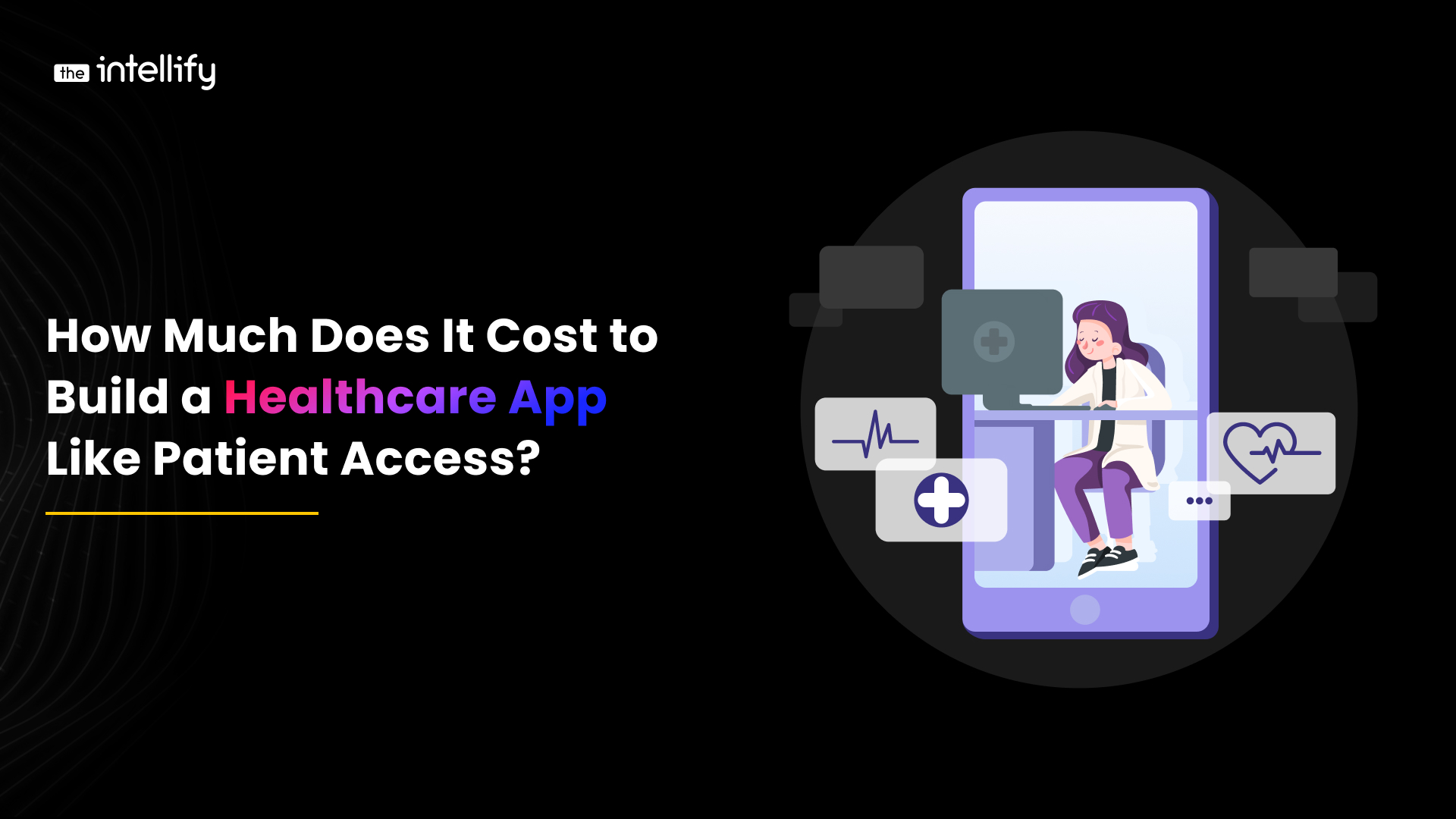

How Much Does It Cost to Build a Healthcare App Like Patient Access?
Costs of Developing Healthcare Apps In the quickly changing landscape of digital healthcare, patient-centric apps like Patient Access have emerged as critical tools for improving patient care and expediting medical procedures. These apps let users arrange appointments, access their medical information, manage medications, and contact healthcare providers from the comfort of their own homes. The […]
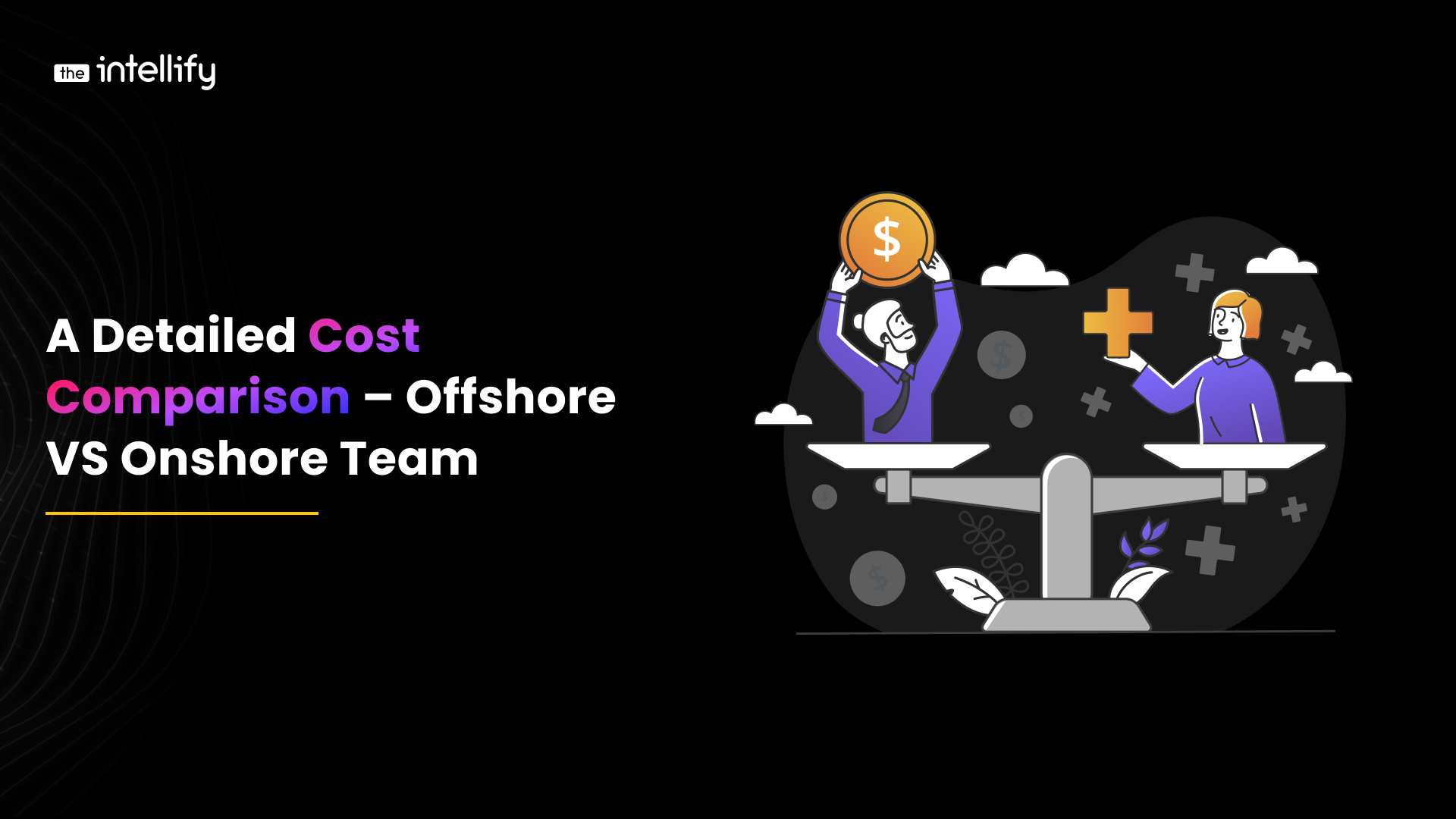

A Detailed Cost Comparison Offshore VS Onshore Teams
Detailed Cost Comparison Offshore VS Onshore Teams The world is always changing due to globalization. The choice between offshore vs onshore outsourcing teams is crucial for companies. Thanks to globalization, which erases boundaries. Organizations can depend on a vast talent pool worldwide. This has led to offshore outsourcing. In it, a team from another country, […]


How Much Does It Cost to Build a Marketplace App Like Gumtree?
Detail Guide About Digital Marketplace like Gumtree The world is shifting online. Marketplace apps have emerged as major contenders. They bring buyers and sellers closer than ever. These platforms have cut the method of buying and selling. They have also fostered the market for both people and companies. Of all the marketplace apps, Gumtree is […]


How Much Does It Cost to Build a Healthcare App Like Patient Access?
Costs of Developing Healthcare Apps In the quickly changing landscape of digital healthcare, patient-centric apps like Patient Access have emerged as critical tools for improving patient care and expediting medical procedures. These apps let users arrange appointments, access their medical information, manage medications, and contact healthcare providers from the comfort of their own homes. The […]


A Detailed Cost Comparison Offshore VS Onshore Teams
Detailed Cost Comparison Offshore VS Onshore Teams The world is always changing due to globalization. The choice between offshore vs onshore outsourcing teams is crucial for companies. Thanks to globalization, which erases boundaries. Organizations can depend on a vast talent pool worldwide. This has led to offshore outsourcing. In it, a team from another country, […]


Real Estate Mobile App Development 101: All You Need to Know
Today, the real estate industry is improving with the help of new technology. Mobile applications are one of the major aspects of this shift. Real estate mobile app development has become crucial for such businesses, which must remain relevant. The applications benefit buyers, sellers, agents, and property managers. In the contemporary world, individuals desire convenience […]

0
+0
+0
+0
+
Committed Delivery Leads To Client Satisfaction
Client Testimonials that keep our expert's spirits highly motivated to deliver extraordinary solutions.

Let’s start a Conversation about your Business Goals!
Drop us a line to Start a Project with us
Contacts For Business
Contacts For Career












